
| Part of a series on |
| Jainism |
|---|
 |
Bagherwal is a digambar Jain community originally from Baghera, a princely state in Rajasthan. The town is situated in Ajmer district of Rajasthan near Kekri.

| Part of a series on |
| Jainism |
|---|
 |
Bagherwal is a digambar Jain community originally from Baghera, a princely state in Rajasthan. The town is situated in Ajmer district of Rajasthan near Kekri.
Stone inscriptions from the eleventh century A.D. refer to this community as located in Chittorgarh, Ranthambore and Mandalgarh at various times. During the foreign aggression of North India in the twelfth century, the community left these forts and spread to villages and towns of Rajputana and Madhya Pradesh. About six hundred years ago, three hundred families migrated to Maharashtra from Chittor under the leadership of Jijaji and Punaji Khatod. This group settled in Maharashtra. [1]
All community members are followers of the Jain religion (Digambar). The community has built Jain temples in Rajasthan, Madhya Pradesh, Maharashtra. Kirti Stambh, built by one of the community members, Jijaji Kathod, at Chittor fort is a historical monument. It is a seven-story structure built in the twelfth century AD.
Different clans have followed different monastic lineages, Mula Sangh Balatkara Gana, Mula Sangh Sena Gana and Kashtha Sangha. Their center in Karanja Lad had thus seats of three bhattarakas of each of the three traditions. [2]
Pandit Ashadhar, a scholar of Jain philosophy in the 13th century, writer of about 100 manuscripts in Sanskrit, was born in this community. [3]

Chanderi, is a town of historical importance in Ashoknagar District of the state Madhya Pradesh in India. It is situated at a distance of 127 km from Shivpuri, 37 km from Lalitpur, 55 km from Ashok Nagar and about 46 km from Isagarh. It is surrounded by hills southwest of the Betwa River. Chanderi is surrounded by hills, lakes and forests and is spotted with several monuments of the Bundela Rajputs and Malwa sultans. It is famous for ancient Jain Temples. Its population in 2011 was 33,081.

Kundalpur is a town located in Damoh district in the Indian state of Madhya Pradesh. Located 37 kilometres northeast of the city of Damoh, Kundalpur is a pilgrimage site for Digambar Jains.

Dhundhar, also known as Jaipur region, is a historical region of Rajasthan state in western India. It includes the districts of Jaipur, Neem ka Thana, Dantaramgarh part of Sikar District lying to the east of the Aravalli Range, Dausa, Sawai Madhopur, Tonk, the southern part of Kotputli and the northern part of Karauli District.
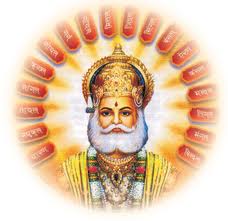
Agrawal is a Hindu Bania community. The Banias of northern India are really a cluster of several communities, of which the Agarwal Banias, Maheshwari Banias, Oswal Banias, and Porwal Banias are mentioned separately in connection with certain They are found throughout northern and central India, mainly in the states of Rajasthan, Haryana, Punjab, Jammu and kashmir, Chandigarh, Himachal Pradesh, Uttarakhand, Delhi, Chhattisgarh, Gujarat, Maharashtra and Uttar Pradesh. They are also found in Pakistani provinces of Punjab and Sindh, though at the time of the partition of India, most of them migrated across the newly created border to independent India. The majority religions followed by the Agrawals include Vaishnava Hinduism and Jainism.
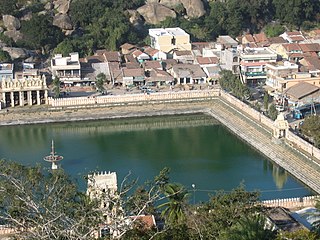
A Bhaṭṭāraka heads traditional Digambara Jain institutions. He is responsible for training scholars, maintenance of libraries, managing endowments, presiding over installation ceremonies and running Jain institutions.

Bundelkhand, a region in central India, has been an ancient center of Jainism. It covers northern part of Madhya Pradesh and south western part of Uttar Pradesh.

Jainism has been present in Maharashtra since ancient times. The famous Ellora Caves demonstrate that Jainism was part of a thriving religious culture in Maharashtra in premodern times.
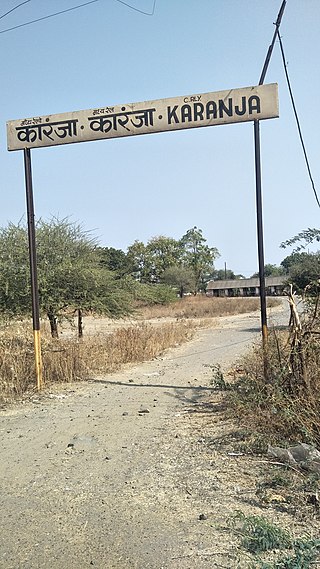
Karanja Lad, or Karanja, is a city of a Municipal council in Washim district in the Indian state of Maharashtra. The town is named after Saint Karanj. Karanja is a holy place for Hindus, Jains, and Muslims. It is the birthplace of Shri Narasimha Saraswati Swami Maharaj, believed to be the second incarnation of Lord Dattatreya.

Kirti Stambha is a 12th-century tower situated at Chittor Fort in Chittorgarh town of Rajasthan, India.
Kashtha Sangha was a Digambar Jain monastic order once dominant in several regions of North and Western India. It is considered to be a branch of Mula Sangh itself. It is said to have originated from a town named Kashtha.

Balatkara Gana is an ancient Jain monastic order. It is a section of the Mula Sangh. It is often termed Balatkara Gana Sarasvati Gachchha. Until the beginning of the 20th century it was present in a number of places in India. However all its seats in North India became vacant in early 20th century. It survives only at Humbaj in Karnataka, which is its ancient seat.

Parwar, also spelt as Paravāra, is a major Jain community from the Bundelkhand region, which is largely in Madhya Pradesh, but also includes the two districts of Lalitpur and Jhansi in Uttar Pradesh. Apart from them, Nagpur district (Maharashtra) have also a very large Parwar community. There is an area in Itwari of Nagpur known as Parwar-Pura having large number of Parwar's homes and shops. Most of the Nagpur's Parwar are migrated from Sagar, Deori, and other small villages of Sagar District of MP. Parwar exclusively follow the Digambar Jain tradition. Parwar usually preferred their marriage within community. There are 12 Gotra in Parwar community. Each Gotra has 12 Moor (lineages). A marriage within the same gotra or lineage are not allowed. Traditionally a marriage within any of the 8 branches was not permitted and hence the community was termed ashta-shakha.
Narsingpura is one of the Jain communities. It originated from the Mewar (Rajasthan) region. Many of them have migrated to Gujarat, MP, and recently to Maharashtra.

Jivaraja Paprival was the installer of as many as 100,000 Jain images in the 15th century, now found in Jain temples all over India. He was a trader in the town of Modasa believed to be in Gujarat. He was probably born in Surat, Gujarat.
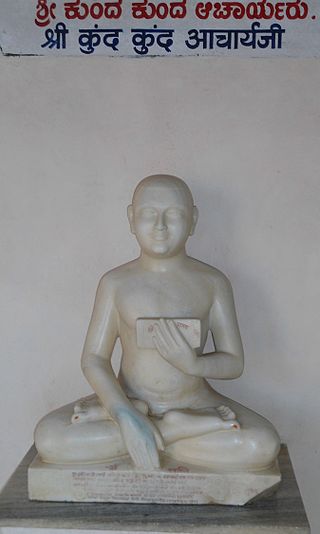
Digambara is one of the two major schools of Jainism, the other being Śvetāmbara (white-clad). The Sanskrit word Digambara means "sky-clad", referring to their traditional monastic practice of neither possessing nor wearing any clothes.
Vidyadhar Pasusa Johrapurkar is a Sanskritist, social anthropologist and historian. His name is sometimes spelt as Vidyadhar Pasusa Joharapurkar. He specializes in Jainism and Jain philosophy.

Jainism is an Indian religion which is traditionally believed to be propagated by twenty-four spiritual teachers known as tirthankara. Broadly, Jainism is divided into two major schools of thought, Digambara and Śvetāmbara. These are further divided into different sub-sects and traditions. While there are differences in practices, the core philosophy and main principles of each sect is the same.
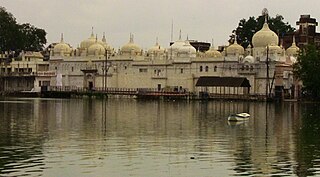
Bara Mandir is a historic Jain temple in Jabalpur, India, right on the edge of Hanumantal, once the main center of Jabalpur.

Pateriya Ji, is a jain temple site in Madhya Pradesh, India, on the outskirts of Garhakota in Sagar district. This is an atishaya kshetra